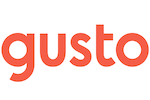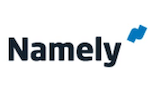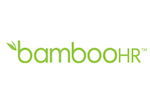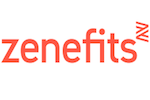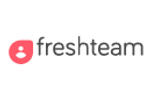Want to jump straight to the answer? The best HR software for most people is Gusto.
People love their job for any number of reasons, but a few definite reasons will make them hate it: missing a paycheck, getting no recognition, and failing to see a rewarding future from their desk.
The best human resources (HR) software helps you execute routine tasks flawlessly. Paychecks go out, time off is tracked, and the trains run on time with a lot less work.
It also makes the complex human side of the business more routine—performance reviews are automatically initiated and employees can take part in growing their role at a company for years to come.
My view is that it’s never too early to get HR software. And it’s certainly never too late.
For the five-person company that’s going to stay a five-person company—sure, use spreadsheets if you don’t mind the hassle. I’d still be very surprised if you were actually saving money based on the time you’re spending.
With more than 10 employees though, you’ll be a hero if you get HR software that really works.
Don’t just take it from me. We talked to 10 active users and recent buyers of HR software, including the products we reviewed here. They told us exactly how much time they saved and how grateful they were for making the switch.
Digitizing HR for the first time is going to take some work. Transitioning from your old HR software won’t be “fun.” But nobody I talked with would go back to the way things were before they got set up with the right solution.
Keep reading to learn more about the best HR software, how it works in practice, and how to decide which option will serve your organization best.
The 5 Best HR Software Options
These are the five best tools you can use right now to find efficiencies and make your office feel like a more rewarding place to be:
- Gusto – Best for your first 50 hires
- Namely – Best for businesses that have outgrown basic HR solutions
- BambooHR – Best support for a small in-house team
- Zenefits – Best for hands-on HR administrators
- Freshteam – Best for shortening your time to hire
As you can see from the rankings, I’ve recommended each of these options for a particular type of user. In the reviews that follow, I’ll explain why based on our research and interviews.
There is a lot to know about HR, but ultimately you know what your company needs more than any outsider. You know your roadblocks.
My reviews will clarify which HR tasks each platform can help with and perspective from the active user interviews will help you get a sense of how well each one succeeds.
I’ve concluded the post with a methodology that explains the rankings and a brief tactical section that will help you assess how these products will fit your company.
#1 – Gusto — Best for Your First 50 Hires
- Trusted by 100k+ businesses
- Payroll and benefits
- Manage compliance
- Month-to-month pricing
Gusto is all that a startup or small company needs for HR software in 2021. Employees love it, administrators don’t have much to worry about, and it comes at a price well within budget for even the youngest business.
I highly recommend it to people who don’t have an HR department. Someone with near-zero HR experience will be able to act as a competent administrator in Gusto.
Everyone we spoke to said implementation was quick and painless. All you need in terms of IT infrastructure is an internet connection.
The platform is continually improving and adding new features, but it’s remained incredibly simple to use across the company. It might be a little thin for the needs of larger organizations, but it’s more than enough for a startup or small business.
Here’s a quick view at what HR needs Gusto can handle:
- Employee database
- Payroll
- Benefits administration
- Onboarding
- Time off management
- Time and attendance
All of this is managed through the Gusto platform—you don’t need to integrate tools or sign into multiple accounts to track time, manage PTO, or change someone’s address. In fact, most admins are simply approving changes employees make themselves.
Gusto basically onboards your employees itself, collecting all the important tax and verification docs. Employees don’t have to download an app to sign an offer letter, Gusto has that baked in.
People are not intimidated by Gusto in the slightest. The users we spoke with said their employees were able to do virtually everything on their own.
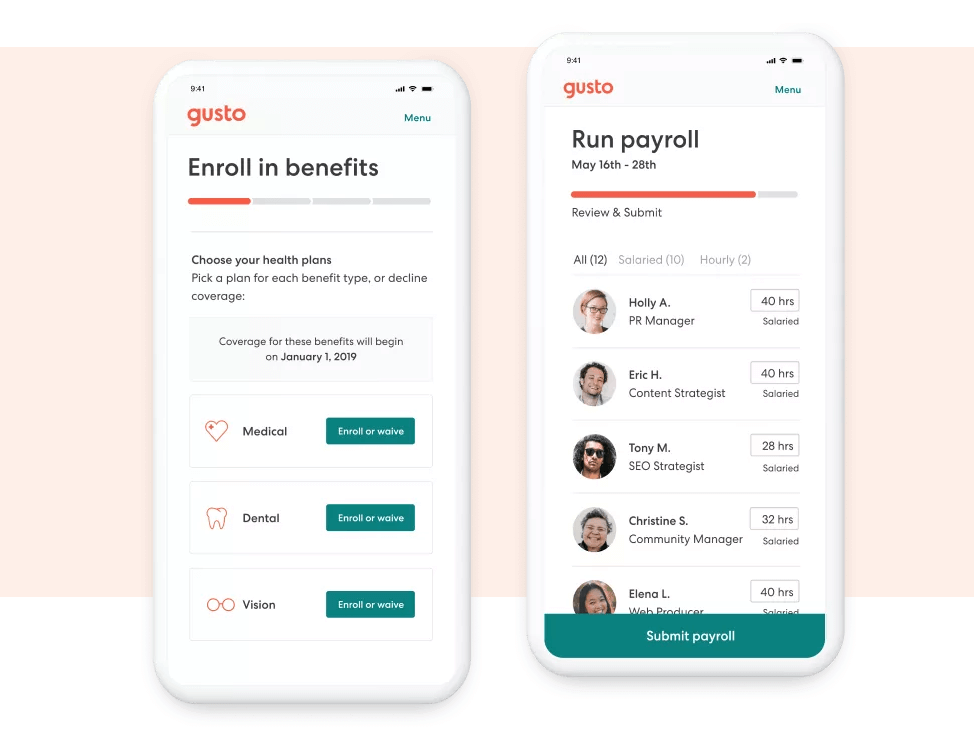
Whether they sign in from their laptop or the mobile app, employees get a super-friendly interface and access to loads of self-help resources.
“I really had actually no complaints about it,” said the founder of a nine-person marketing agency. He received a lot of complaints about their prior system, describing it as “not as easy to use” and “a little bit more confusing.”
With Gusto, he said, “It’s been way better than expected as far as [the employee portal] goes.”
Gusto is welcoming to the point of almost being cheesy. There’s a dancing piggy bank and plenty of digital high-fives for tasks like completing your annual enrollment. But those tasks are incredibly important (ask any employee who missed the open enrollment window) and the tangible benefits of having an HR platform as engaging as Gusto cannot be overstated.
As a restaurateur told us, the simple design of the platform allows his employees to answer their own questions.
“You can get all the answers without having to send the flag up the chain,” he said. “That’s going to save a lot of unnecessary time that managers usually have to deal with week after week.”
And it’s more than just finding efficiencies. The restaurateur has seen a decrease in turnover, crediting Gusto in part for the high employee retention.
“They love the fact that if there is any discrepancy, it’s quickly resolved and processed,” he said. And errors are few and far between. “It just makes for a very consistent, steady atmosphere, even in the current social climate.”
The back end is just as good as the front end. You don’t need any formal HR experience to set up your company. Gusto walks you through the nuts and bolts, even sending the occasional timely reminder.
“I actually have someone starting today,” the restaurateur said when he talked to us. “And, sure enough, without even setting a reminder or anything, [Gusto] was like, ‘Hey, remember when she gets there, let’s go ahead and complete the I9, and that way you don’t have to worry about it anymore.’”
Without Gusto, he said he wouldn’t have thought to do it until his accountant hassled him at the last minute. He would have had to call his new worker at some random hour to make sure she could receive her first paycheck. Talk about avoiding a bad first impression.
Things like reimbursements are a walk in the park. You can set recurring reimbursements, bulk edit to do a bunch at once, or make it right with an employee who had to float a purchase on their own personal card.
“They can submit the receipt,” said the founder, “[and] boom, we reimburse them—nice and easy.”
One reason a lot of people chose Gusto was its time tracking capability. It used to be desktop-only, but now you can clock in and out directly from the app, which is a welcome improvement.
One manager who used the system told us it hardly requires any training, “maybe two to three minutes for someone who’s never seen it before.” She really appreciated the ability to edit hours easily, and that all edits were tracked.
Potential Drawbacks of Running HR with Gusto
Gusto is great at what it does, but there are some HR tasks that it just doesn’t handle. In the future, I could see more built-in tools for recruiting, performance management, and so on being added.
For now, you’ll have to rely on integrations to extend Gusto’s functionality. For companies that know they need more than what Gusto can do on its own, it makes sense to seriously consider whether they’ll still be able to centralize HR work for their department and employees.
You could wind up having to add tools to an ever-increasing stack. Don’t get me wrong, it’s a great solution in its own right, it’s just that there are ways to handle a lot more of HR under one umbrella with Namely, Zenefits, and even BambooHR, to some extent.
But this wasn’t a pressing need for most of the people I talked with. They tended to have fewer than 50 employees and Gusto’s ability to deal with the basic back office stuff was more than enough.
“If I wanted to be really tough,” said one user trying to come up with a criticism of the platform, “some of the reports are hard to find and they’re not necessarily that pretty.”
For some of the other users I talked with, the limited reporting and lack of performance management would have made Gusto a non-starter. Generally, though, these users were at much larger companies or those that had become complex while keeping a lower headcount.
Your typical company just starting out is not going to hit Gusto’s limits for the first couple of years. And when they have to jump ship, they’ll be moving to a product that would have made no sense to use for the first few dozen hires.
Gusto Pricing
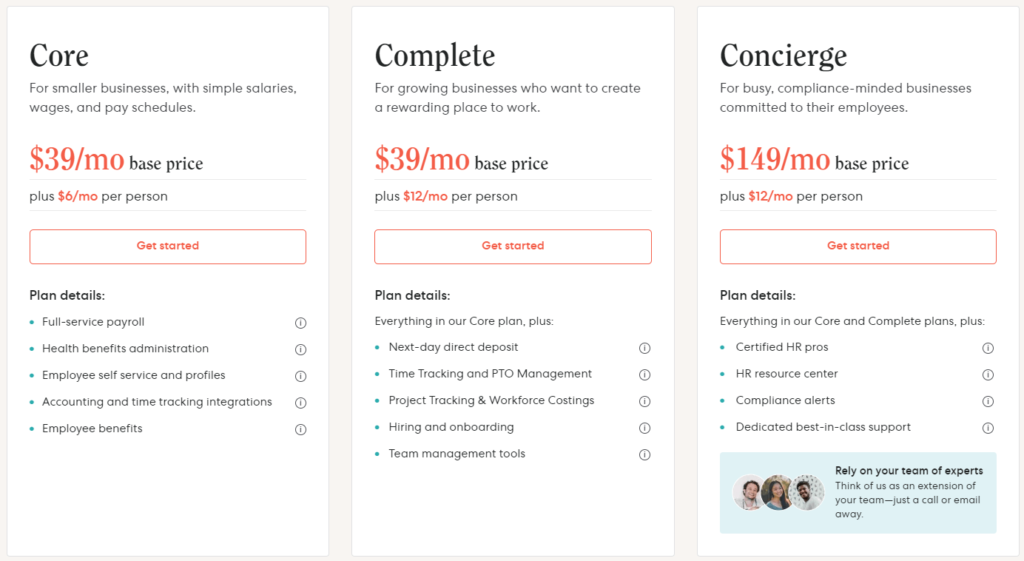
There are three packages offered by Gusto, as well as add-ons for things like Workers Compensation Insurance , 401(k) plans, and so on. Each package includes a base price, and a cost per person:
- Core — $39 per month + $6 per person
- Complete — $39 per month + $12 per person
- Concierge — $149 per month + $12 per person
Core is very good for the price, as it covers payroll, benefits administration, and Gusto’s best-in-class employee self-service portal. One notable thing it does not cover is PTO policies. For a really small business, this will be fine.
Upgrading to Complete gives you the PTO, tools for onboarding, and some better reporting and organization tools that become important once you have more than a handful of employees.
Even if you think you can get by with one of the other plans, my recommendation is the Concierge plan. This is where you get a dedicated customer support rep, phone service, and a number of other HR resources to help you steer the ship. You also get access to domain experts in compliance, tax law, and employee relations.
Yes, it’s a steep jump in the monthly base price compared to Complete, but the added customer support is worth it for companies just starting out.
There’s a ton of ways to screw up basic HR tasks at a new company. I can back that up with personal experience. Getting timely answers can prevent fines, touchy paycheck problems, and save you hours of re-doing things the right way.
We found a range of comments about Gusto’s customer service in the public reviews. Some people were really frustrated. In our interviews, though, we encountered only happy customers.
“They get back to you real quick,” said one user of Gusto’s support team.
Another said that she wished Gusto’s customer service could handle everything in her life.
“Every time I have had an issue or been confused,” she said, “they have been so patient and helpful.”
The simple explanation is that these folks were getting the premium customer support on the Concierge plan. I recommend you do, too, unless you’ve got the in-house experience to deal with thorny issues on your own.
Why We Ranked Gusto at #1
No HR software seems to make small business problems disappear quite like Gusto does. It completely handles the basics of payroll, benefits, and HR administration. All of that is consolidated in a system that’s easy for employees and admins to master.
While it probably has some limits that would annoy midsize companies, organizations just starting out aren’t going to run into any problems. Every service Gusto provides is more than good enough for your first 50 or so hires.
“Honestly, it was pretty mind blowing,” said one small business owner. “Having gone through really terrible payroll cycles in the past, where I have multiple data entry sources everywhere, to all of a sudden be like, ‘Oh, you know what? We’re actually good to go.’”
Bottom line: Startups and small businesses are good to go with Gusto.
#2 – Namely — Best HR Software for Mid-Sized Companies
- Made for mid-sized businesses
- Easy to scale
- Built-in payroll processing
- Lots of integrations
>> Compare Quotes
Namely is another full-service HR solution that comes at a great price.
With 1,400+ businesses being served, Namely isn’t quite as popular as some of the other options on our list. Despite that, Namely’s HR solution has everything you need to manage a mid-sized HR department at scale.
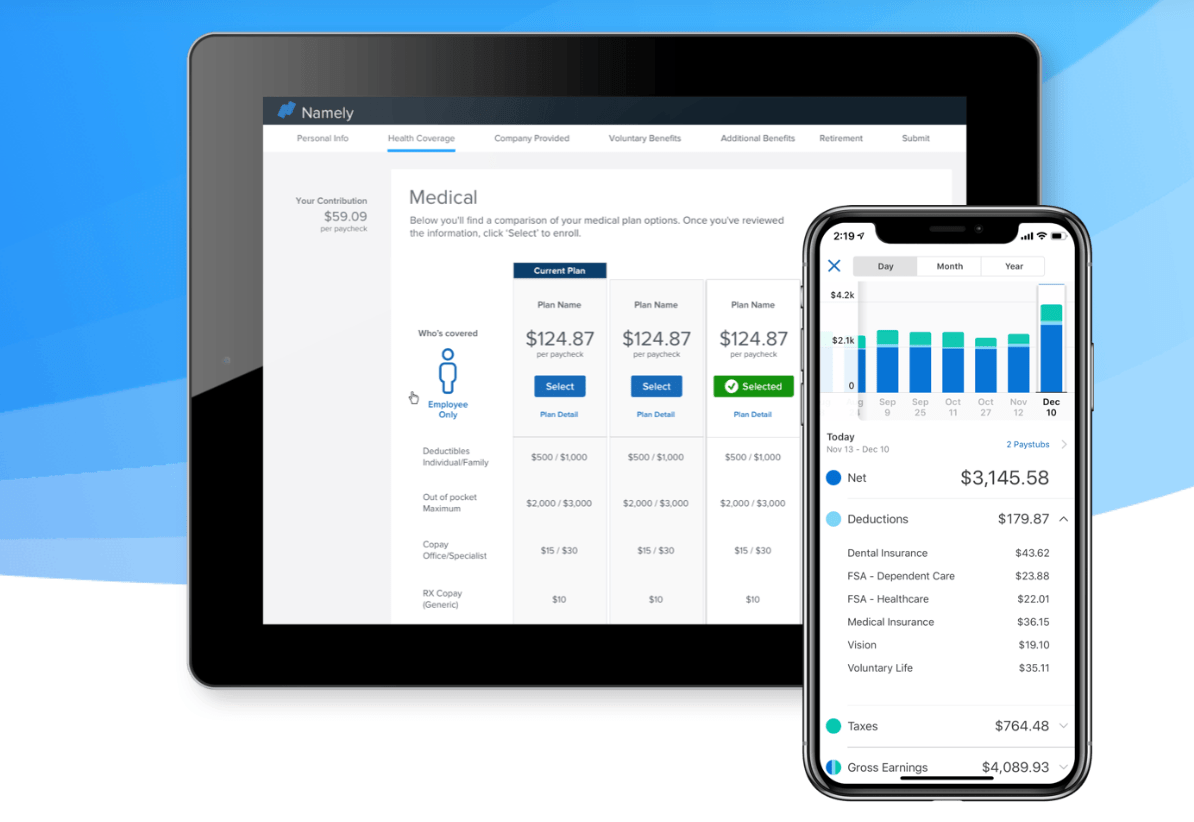
With Namely, you’ll benefit from core features like:
- Employee management
- Onboarding
- Talent management
- Benefits administration
- Payroll
- HR compliance
- Analytics
- Recruiting
- Time and attendance
- Benchmarking
With all these tools, along their unique support contact for your company, they’re a perfect fit for mid-sized operations who have room to scale.
You’ll have access to live HR advisers, a learning management system, a living handbook, and OSHA logs to manage your HR compliance. Namely has enhanced services for things like benefits consulting as well.
The software is easy to use, and employees love it. Accessing pay stubs and requesting time off is just a few clicks away from the web portal or mobile app.
On average, HR departments save 11 hours per week by switching to Namely. Imagine how much more productive you could be with an extra 572 hours per year to spare.
Namely integrates with third-party tools for things like applicant tracking, e-sign, time and attendance systems, background checks, international payroll, and more. If you’re using already using a tool and can’t find it on the pre-built list of integrations, you can build your own through the secure Namely API.
Pricing for Namely HR is not available online. You’ll need to request a free demo and quote.
#3 – BambooHR — Best Support For A Small In-House Team
- For small and medium businesses
- 1.56+ million active employees
- Great mobile app
- 7 day free trial
For businesses seeking a complete HRMS solution, BambooHR will be a top choice for you to consider.
This software is trusted by more than 17,000 companies and has 1.56+ million active employee users for very good reason.
BambooHR places a big emphasis on your employees. The software specializes in hiring, onboarding, compensation, and company culture.
Designed for small and medium businesses, the solution makes it easy for business owners and HR departments to collect, maintain, and analyze data about their employees. This information will ultimately help the way you hire new talent and create a culture that empowers your team.
They also offer an excellent user interface. That way even the newest employee can learn the ropes quickly.
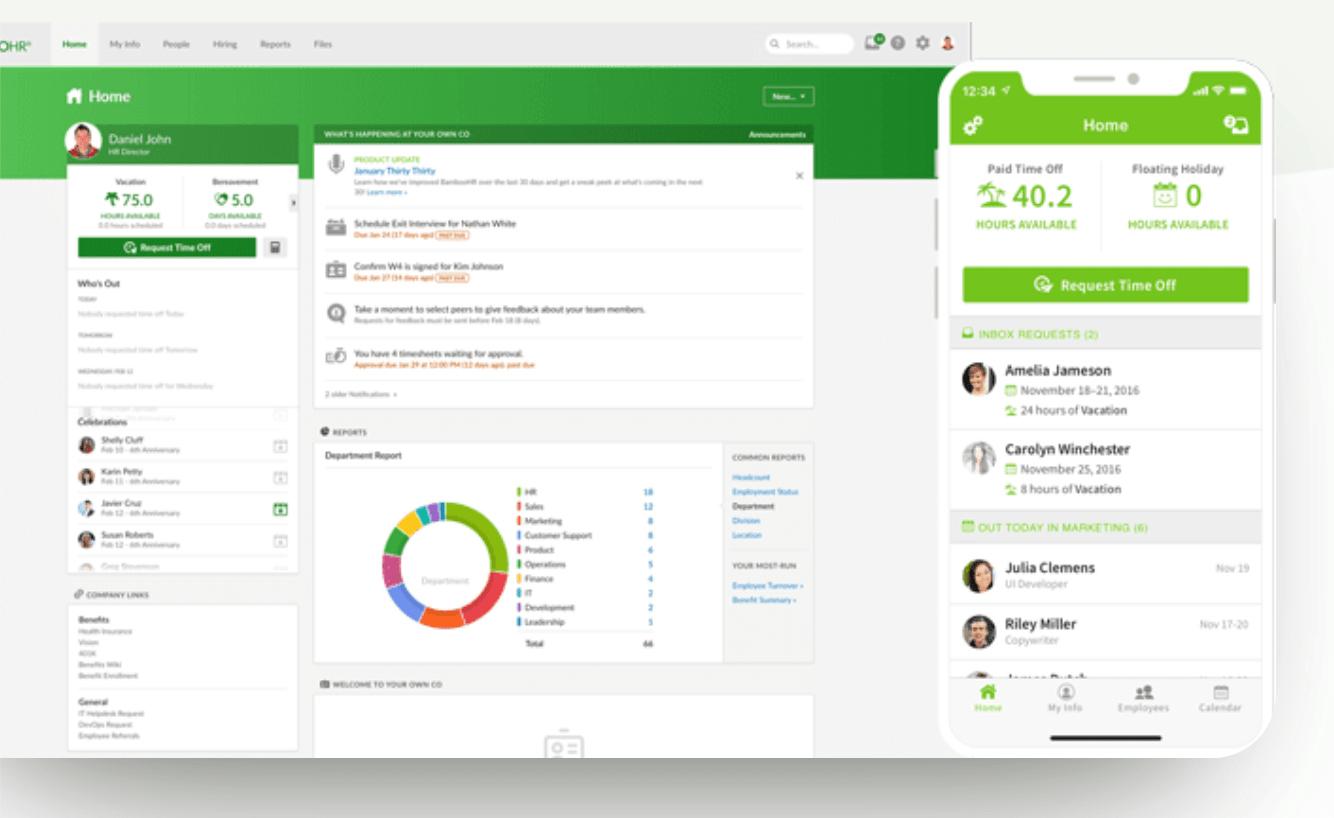
Some of the top features offered by BambooHR software include:
- Employee records
- Benefit tracking
- Time off management
- Company calendar
- Onboarding and offboarding
- Applicant tracking system (ATS)
- Training
- Company branding
- Advanced HR reporting
- Tailored workflows and approvals
BambooHR also has an exceptional mobile app that’s ideal for employees and HR administrators alike. You can purchase add-ons for things like performance management and time tracking.
Pricing for BambooHR is not available online. You’ll need to contact their sales team to get a quote.
Unfortunately, payroll isn’t available for this software. So you’ll need to run your payroll elsewhere. Check out our guide of the best online payroll services for some guidance in that department.
Try BambooHR free for seven days.
#4 – Zenefits — Best for Hands-On HR Administrators
- All-in-one HR solution
- Starting at $8 per month
- Free payroll for one year
- 14 day free trial
>> Compare Quotes
Zenefits is trusted by 11,000+ businesses and used by more than 400,000 employees.
Where they really shine though is their all-in-one HR solutions. Zenefits provides features for compensation packages, employee onboarding, PTO management and requests, employee management, and more.
The provide built-in compliance features and safeguards to help you prevent accidental mistakes. The software automates the majority of compliance tasks and government filings as well.
With Zenefits, you’ll be able to increase employee productivity throughout your organization. Your staff can use Zenefits for things like self onboarding, choosing benefits, and signing documents.
Here’s a quick overview of the plans and pricing for Zenefits:
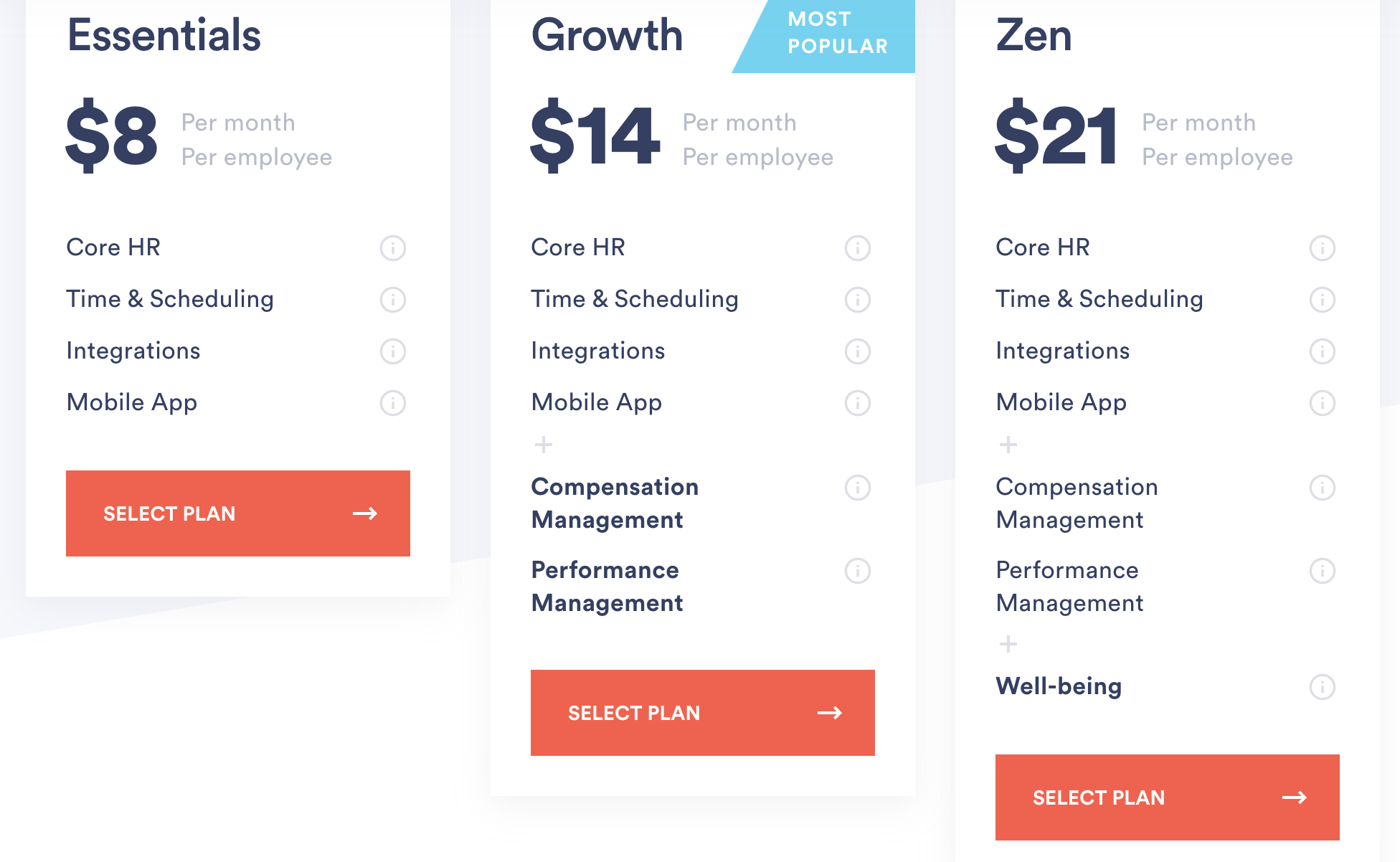
The rates are affordable. Also, depending on the size of your organization and the needs of your HR department, there’s a plan for everyone.
Payroll is not included in any of the base plans, but you can add it on for $6 per employee.
For a limited time, Zenefits is offering one free year of payroll to help small and midsize businesses during the COVID-19 pandemic. There are some restrictions; for example, you must sign up for an annual HR subscription plan.
Try Zenefits free for 14 days.
#5 – Freshteam — Best for Shortening Your Time To Hire
- End-to-end recruiting tool
- Full of powerful features
- Wildly customizable
- Find and attract the best talent
Your company can only be as good as the people it hires. HR managers are in a unique position of making sure the current staff is happy while also having to identify and court talented individuals who would be an asset to the team.
Freshteam, from the folks at Freshworks, is an end-to-end HR software solution that is particularly adept at assisting with recruitment, hiring, and onboarding.
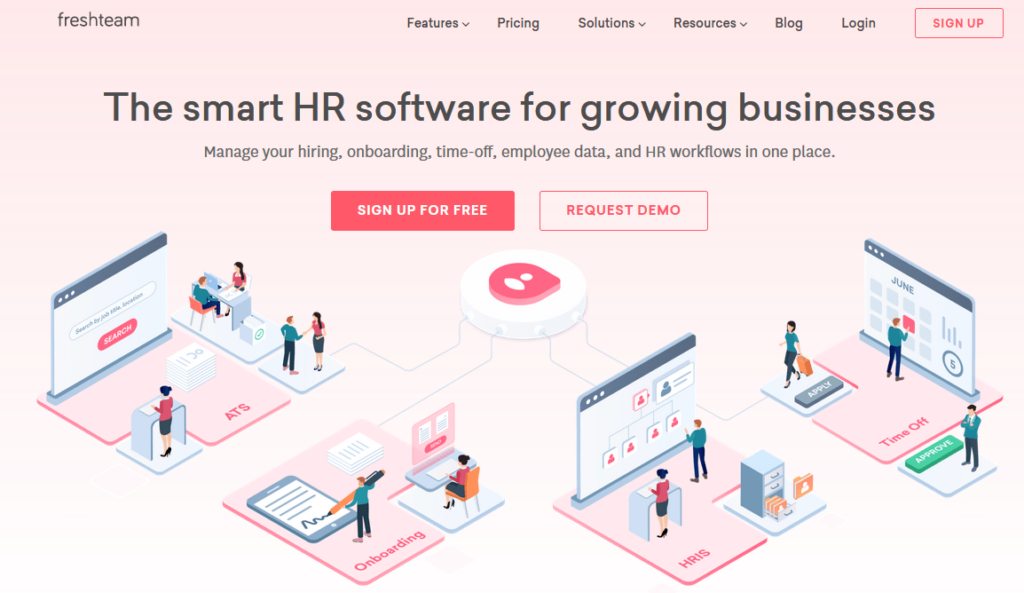
It starts with Freshteam’s Recruitment Management System, which will both streamline and bolster your job posting process. You get incredible control in how you list openings at your company, including the ability to customize every step of interviewing and hiring to map precisely to the position you’re looking to fill.
Plus, it allows you to create questionnaires within each job posting that are also tailored to gathering the information you need to determine an applicant’s fit with the position.
If you’re noticing a pattern, you’re not wrong—Freshteam is all about customizing hiring workflows. Everything from how you post openings and receive applications to how you set interview stages and extend offers is flexible so you can bend it to do what you need to it do.
There are even more features in Freshteam’s hiring tools than we have space to include, but some other key elements are:
- Recruit via social media, email, and major job boards
- Build a new, elegant, mobile-friendly careers page or site
- Custom tracking links for web and email applicants
- Employee referrals
- Talent pool for applicants who are appealing but not yet a fit for an open position
- Customize, manage, and send offer letters from within Freshteam
But the software hardly stops there. In fact, that’s just a sliver of its feature set.
After hiring, Freshteam will help similarly with onboarding and training, allowing you to easily send documentation and manuals, collect signatures on hiring forms, and loop in supervisors, trainers, and other stakeholders on new hire status.
Plus, you get many other tools essential for running HR, including time off management, a database for employee information and organization detail, detailed and wide-reaching reporting, and a mobile app for handling everything above while you’re on the go.
Freshteam even offers a free version of the platform, good for up to 50 employees, up to three job postings, and the basic features you need for hiring and onboarding.
But I recommend starting with at least the lowest pricing tier for getting all the good stuff to improve your ability to attract, onboard, and retain talent:
- Growth: $59 base fee plus $1/user per month
- Pro: $99 base fee plus $2/user per month
- Enterprise: $169 base fee plus $4/user per month
The above prices reflect signing up for an annual plan. Both the base fee and per-user price are slightly higher if you elect to pay month-to-month.
Check out Freshteam’s pricing info for greater detail about the features in each package. Then, get started on the free plan to test drive it out.
See how much Freshteam can help your hiring and onboarding today.
What is HR software?
Human resources software helps businesses of all sizes manage various aspects of HR processes such as:
- Hiring
- Employee onboarding
- Training
- Payroll
- Benefits
And much more. HR software makes everything easier for your HR staff and employees alike by giving you the tools you need.
Without HR software, organizations face a bottleneck in the HR department. The only way for employees to access information is by calling HR, sending an email, or physically visiting the HR office.
These scenarios aren’t realistic for the modern workforce, especially with so many people working remotely or in the field.
How to Find the Best HR Software For Your Business
With so many HR solutions on the market today, finding the best option for your business can feel like a daunting task.
Fortunately, I’ll explain what factors and elements you need to take into consideration as you’re evaluating prospective solutions. This is the methodology that we used to pick the winners on our list.
Business Size
The first way to narrow your options down is by the number of employees you have. Startups and small businesses with 20 employees won’t have the same needs as a company with 200 or 2,000 employees.
Startups and small businesses should look to solutions like Zenefits or Gusto. Namely and SAP SuccessFactors are better for medium businesses.
It’s important to make sure that your HR software can scale with you as your company grows.
HR Needs
What exactly do you need HR software for?
My needs might not be the same as yours. Not all software provides every single HR capability. So you need to identify the main reason why you’re seeking HR software.
For example, you won’t find payroll on the feature list for the majority of software on our list. In most cases, you’ll have to pay extra to get payroll on the few platforms that do offer it.
Other solutions address specific needs, like human capital management (HCM), applicant tracking systems (ATS), and human resources management system (HRMS). Some providers address ultra-specific needs, such as HR software for managing international employees.
Additional Features
In addition to your core needs, you should look to see what other additional features are offered by the software you’re evaluating.
Mobile apps and employee self-service tools are nice to have. Time tracking, time-off management, onboarding tools, and dozens of other features won’t necessarily fall into the “core HR” feature list. But they’re still great to have if you’re trying to optimize your HR department.
Some on our list, like Deputy, really home in on these features more than core HR tools. Or, Freshteam is one that has much of the essentials but particularly shines in recruitment and onboarding.
Just don’t let a long list of additional features distract from your primary HR needs.
Price
Most HR software is billed on a monthly basis per employee. These rates can start as low as $5 per employee per month.
Some platforms charge a base rate for your core plan, and then charge a per employee rate on top of it. Other software has different per employee rates based on the features available in the plan you select.
Not every HR solution has transparent pricing available online. In some cases, you’ll have to contact the sales team to request a quote and demo. Always test out the software with a free trial when its available before you commit to anything long term.
Conclusion
What’s the best HR software on the market today? Generally speaking, there is no “best for everyone” solution — but we really recommend these ones:
- Gusto – Best HR software for small business payroll.
- Deputy – Best for never worrying about scheduling again
- Freshteam – Best talent management solution
- BambooHR – Best human resources management systems
- Sage Business Cloud People – Best for multinational organizations
- Zenefits – Best all-in-one human resources software
- Namely – Best HR software for mid-sized companies
- SAP SuccessFactors – Best HCM software suite
If your priority is small business payroll, choose Gusto. For a complete HRMS, try BambooHR. Mid-sized organizations should learn towards solutions like Namely.
Freshteam is our top recommendation for applicant tracking and recruitment.
Need to improve and streamline your staff scheduling? Look no further than Deputy.
Check out SAP SuccessFactors for an HCM product suite. For mid-sized organizations with international employees, we recommend Sage Business Cloud People.
Regardless of your business size, industry, or HR needs, you can find what you’re looking for using this guide.
from Quick Sprout https://ift.tt/3gwg6hk
via IFTTT
